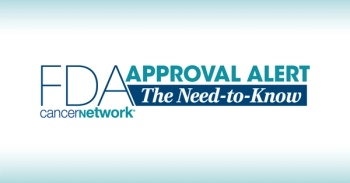
Tuspetinib Exhibits Enhanced Efficacy in Diverse Newly Diagnosed AML Group
No minimal residual disease-negativity was observed with tuspetinib in patients with AML, including in a patient with more than 7 months of follow-up data.
The addition of tuspetinib (HM-43239) to venetoclax (Venclexta) and azacitidine (Vidaza) exhibited enhanced efficacy outcomes in a diverse cohort of patients with newly diagnosed acute myeloid leukemia (AML) vs venetoclax/azacitidine alone, according to a news release from the drug’s developer, Aptose Biosciences.1
Specifically, patients treated with 80 mg or 120 mg of tuspetinib in the phase 1/2 TUSCANY trial (NCT03850574) exhibited a 100% complete response (CR)/CR with partial hematologic recovery (CRh) rate. Furthermore, the addition of tuspetinib to venetoclax/azacitidine elicited minimal residual disease (MRD)-negativity in 7 of 9 (78%) of responders vs 40.9% of responders treated with venetoclax/azacitidine.
Further data revealed that among 10 patients treated with either 40 mg, 80 mg, or 120 mg of tuspetinib as combination therapy, the CR/CRh response rate was 90% vs 65% with venetoclax/azacitidine alone. Additionally, 100% of the NPM1-mutated, FLT3-ITD, and TP53-mutated population (each arm, n = 2) achieved CR/CRh responses, vs 67%, 61%, and 52% of patients treated with azacitidine/venetoclax. The MRD-negativity rate among all patients treated with tuspetinib was 70% (n = 7/10) vs 23.4% of patients treated with venetoclax/azacitidine alone.
Additionally, according to the release, no dose-limiting toxicities were observed with the investigational agent, and it was well-tolerated among these patients. Furthermore, no loss of MRD-negativity was observed on trial, even among a patient with 7 months of follow-up data. No relapses or treatment-related deaths have occurred to date, and the only non-responder to treatment with tuspetinib at the 40 mg level did not achieve exposures previously associated with response and advanced to hematopoietic stem cell transplantation.2
“The addition of tuspetinib to venetoclax plus azacitidine appears to boost response rates and MRD-negativity while maintaining favorable safety and tolerability,” Rafael Bejar, MD, PhD, chief medical officer of Aptose, said in the news release.1 “The 100% CR/CRh and 100% MRD-negativity rates among the five biallelic TP53-mutated, FLT3-ITD, and RAS-mutated AML cases are exciting to see, as this can correlate with longer overall survival [OS]. We have observed a trend towards achieving CRs more quickly at the higher dose levels, so we are keen to see the activity as we advance into the 160 mg tuspetinib dose cohort.”
The phase 1/2 study consisted of 4 parts, which included a dose escalation, dose expansion, and 2 dose exploration phases.3 Tuspetinib was initially assessed as a single agent for up to 6 dose levels in the dose escalation cohort, with patients advancing to a dose exploration cohort if they achieved a clinical response. The dose expansion phase assessed tuspetinib as a single agent or with venetoclax, with an initial dose of 120 mg explored in the monotherapy cohort and 80 mg explored in the combination cohort.
The second dose exploration phase assessed tuspetinib with both venetoclax and azacitidine and was planned for a maximum of 6 dose levels, with an initial dose of 40 mg. Patients treated in this cohort received escalating doses of tuspetinib, as well as oral venetoclax as 50 mg or 100 mg tablets and intravenous azacitidine at a dose of 75 mg/m2.
The primary end points of the trial included the frequency and severity of drug-related adverse effects (AEs), the maximum tolerated dose or recommended phase 2 dose, and plasma concentration. Secondary end points included CR/CRh rates, overall response rate, duration of response, disease-free survival, OS, and event-free survival.
Patients were eligible for trial enrollment if they had morphologically documented primary or secondary AML refractory to at least 1 cycle of prior therapy, if they experienced a recurrence after achieving remission with a previous therapy, if they had an ECOG performance status of 0 to 2, and had a minimum life expectancy of at least 3 months.
References
- Aptose reports early data demonstrating tuspetinib improves standard of care treatment across diverse populations of newly diagnosed AML in phase 1/2 TUSCANY trial. News release. Aptose Biosciences. August 18, 2025. Accessed August 19, 2025. https://tinyurl.com/4342rt66
- Aptose Biosciences. Tuspetinib in frontline triple drug therapy to treat newly diagnosed AML. August 2025. Accessed August 19, 2025. https://tinyurl.com/db5rf4kd
- Clinical trial to evaluate the safety, tolerability, pharmacokinetics and pharmacodynamics of tuspetinib (HM43239) in patients with relapsed or refractory acute myeloid leukemia (TUSCANY). ClinicalTrials.gov. Updated December 20, 2024. Accessed August 19, 2025. https://tinyurl.com/yc8e9zzt
Newsletter
Stay up to date on recent advances in the multidisciplinary approach to cancer.






















































































